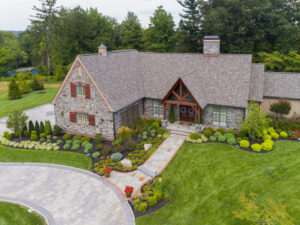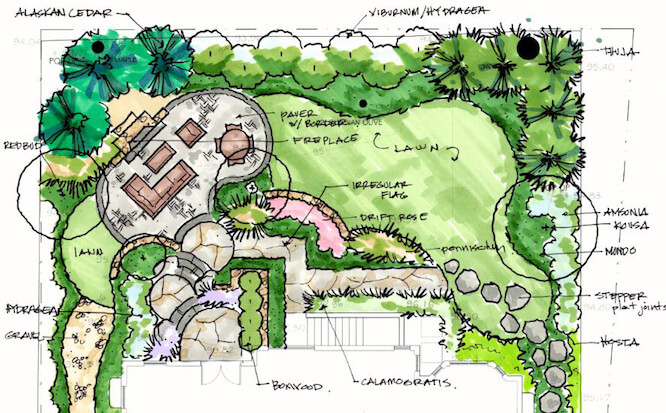Designing a landscape can be a rewarding and creative process that transforms your outdoor space into a beautiful and functional area. Whether you’re starting from scratch or renovating an existing garden, a well-thought-out design can enhance your home’s curb appeal and provide a relaxing retreat. Here’s a step-by-step guide on how to design a landscaping:
Step 1: Assess Your Needs and Preferences
Identify Your Goals:
- Determine the primary purpose of your landscape. Do you want a space for entertaining, gardening, playing, or relaxing?
- Consider your lifestyle and how you plan to use the outdoor area.
Make a Wish List:
- List all the features you’d like to include, such as patios, walkways, flower beds, vegetable gardens, water features, or seating areas.
Evaluate Your Preferences:
- Think about your style preferences. Do you prefer a formal garden, a casual space, a modern look, or a natural, wild landscape?
Step 2: Analyze Your Site
Understand the Conditions:
- Soil Type: Test your soil to determine its type and fertility. Amend the soil if necessary to support healthy plant growth.
- Sunlight and Shade: Observe how sunlight moves across your yard throughout the day to identify sunny, partially shaded, and fully shaded areas.
- Climate and Microclimates: Consider your region’s climate and any microclimates within your yard, such as areas protected from wind or frost pockets.
Identify Existing Features:
- Take note of existing trees, shrubs, structures, and any other elements you want to keep or remove.
- Consider the views from different points in your yard and how you can enhance or obscure them.
Step 3: Create a Base Map
Draw a Rough Sketch:
- Start with a rough sketch of your yard, including property lines, existing features, and any structures like your house, garage, or fence.
- Use graph paper to make a scale drawing, ensuring all measurements are accurate.
Mark Important Elements:
- Indicate where utilities, such as water lines and electrical cables, are located.
- Note the direction of prevailing winds and any drainage issues.

Step 4: Develop a Design Concept
Functional Zones:
- Divide your yard into functional zones based on your wish list and site analysis. Common zones include entertainment areas, play spaces, garden beds, and quiet retreats.
Flow and Circulation:
- Plan pathways and walkways to connect different zones and ensure smooth circulation throughout your yard.
- Consider accessibility and ease of movement for all users, including children, pets, and people with mobility issues.
Focal Points:
- Identify focal points, such as a beautiful tree, a sculpture, or a water feature, to draw attention and create visual interest.
Plant Selection:
- Choose plants that are suitable for your climate, soil, and light conditions.
- Consider the plant’s size, shape, color, texture, and growth habits to ensure they fit well with your design.
- Incorporate a mix of trees, shrubs, perennials, and annuals to create layers and year-round interest.
Step 5: Create a Detailed Plan
Refine Your Base Map:
- Using your rough sketch and design concept, create a more detailed plan. Include specific locations for plants, hardscapes, and other features.
Hardscape Elements:
- Plan the placement and materials for patios, walkways, retaining walls, and other structures. Ensure they are durable, aesthetically pleasing, and harmonize with your overall design.
Planting Plan:
- Detail the exact placement of each plant, considering their mature size and spacing requirements.
- Group plants with similar water, soil, and sunlight needs together to create microclimates and simplify maintenance.
Step 6: Plan for Maintenance
Low-Maintenance Choices:
- Choose plants that require minimal care and are well-suited to your local climate.
- Incorporate mulch and ground covers to suppress weeds and retain moisture.
Irrigation System:
- Design an efficient irrigation system that provides adequate water to all areas of your yard without waste.
- Consider drip irrigation for garden beds and soaker hoses for larger areas.
Step 7: Implement Your Design
Prepare the Site:
- Clear the area of debris, weeds, and unwanted plants.
- Grade the soil to ensure proper drainage and a level surface for planting and hardscaping.
Install Hardscapes:
- Begin with the installation of hardscape elements, such as patios, walkways, and retaining walls. Ensure they are properly constructed to last for years.
Planting:
- Follow your planting plan, starting with trees and larger shrubs, then adding smaller plants and ground covers.
- Mulch around plants to retain moisture and suppress weeds.
Step 8: Add Finishing Touches
Lighting:
- Incorporate landscape lighting to highlight key features and improve safety and usability at night.
- Use a combination of path lights, spotlights, and accent lights for a layered lighting effect.
Furniture and Decor:
- Select outdoor furniture that complements your design and provides comfort and functionality.
- Add decorative elements like sculptures, bird baths, or garden art to personalize your space.
Conclusion
Designing a landscape involves thoughtful planning and creativity to create a space that is both beautiful and functional. By following these steps, you can transform your yard into an inviting outdoor oasis that enhances your home and lifestyle. For professional landscaping design services, contact Green Pulse Landscaping. Let our expert team help you bring your vision to life!
Contact us today for a free estimate at
(857) 504-5117 or email us at
contact@greenpulselandscaping.com to schedule a consultation and learn how we can help you achieve a lush, green lawn.
Click to Call Us!


